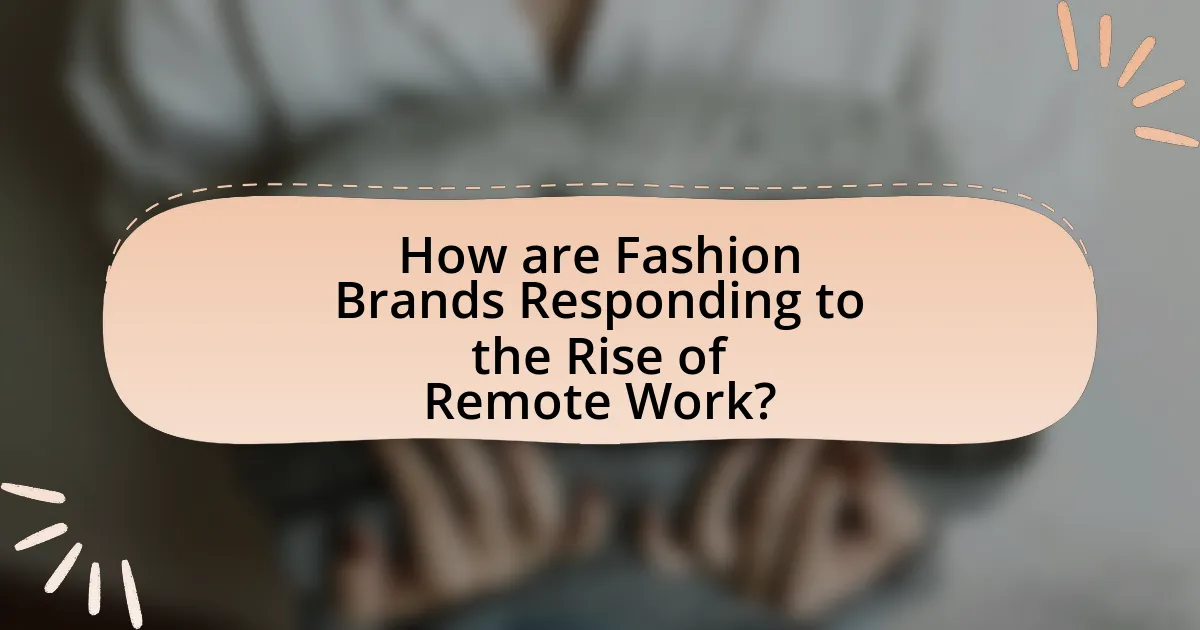The article examines how fashion brands are adapting to the rise of remote work by shifting their focus towards comfortable and versatile clothing options. Key trends include the increased popularity of loungewear, athleisure, and casual styles, as brands like Lululemon and Uniqlo expand their collections to meet consumer demand. The article also highlights the evolution of marketing strategies, emphasizing digital engagement and the use of social media to connect with remote workers. Additionally, it discusses the challenges brands face, such as supply chain disruptions and changing consumer behaviors, while exploring innovations in sustainable practices and technology integration within the fashion industry.

How are Fashion Brands Responding to the Rise of Remote Work?
Fashion brands are responding to the rise of remote work by shifting their focus towards comfortable, versatile clothing that caters to home-based lifestyles. This adaptation includes the introduction of loungewear, athleisure, and casual styles that prioritize comfort without sacrificing style. For instance, brands like Lululemon and Uniqlo have expanded their collections to include more relaxed fits and soft fabrics, reflecting consumer demand for clothing suitable for both work and leisure at home. Additionally, many fashion brands are enhancing their online shopping experiences and investing in digital marketing strategies to reach remote workers effectively, as evidenced by a significant increase in e-commerce sales during the pandemic, which rose by 44% in 2020 according to the U.S. Department of Commerce.
What changes are fashion brands making in their product offerings?
Fashion brands are increasingly shifting their product offerings to prioritize comfort and versatility in response to the rise of remote work. This change is evident as brands introduce more loungewear, athleisure, and casual styles that cater to consumers seeking both style and comfort while working from home. For instance, a report by McKinsey & Company highlights that the demand for comfortable clothing has surged, leading brands like Nike and Lululemon to expand their collections to include more relaxed fits and functional fabrics. Additionally, many fashion brands are incorporating sustainable materials into their offerings, aligning with consumer preferences for eco-friendly products, as noted in the 2022 Fashion Transparency Index, which shows a growing trend towards sustainability in fashion.
How are comfort and functionality influencing design choices?
Comfort and functionality are significantly influencing design choices in fashion brands adapting to remote work. As remote work becomes more prevalent, consumers prioritize clothing that offers ease of movement and comfort for extended wear. This shift has led brands to incorporate softer fabrics, relaxed fits, and versatile styles that can transition from home to video calls seamlessly. For instance, a survey by McKinsey & Company found that 70% of consumers now prefer comfortable clothing over traditional office attire, prompting brands to innovate designs that blend casual aesthetics with practical features, such as stretchability and moisture-wicking properties.
What role does casual wear play in the new collections?
Casual wear plays a pivotal role in new collections as fashion brands adapt to the rise of remote work. The shift towards more relaxed and comfortable clothing reflects the changing lifestyle of consumers who prioritize comfort while working from home. According to a report by McKinsey & Company, 70% of consumers have changed their shopping behavior, favoring casual and athleisure styles that offer versatility for both home and casual outings. This trend indicates that casual wear is not just a temporary response but a fundamental shift in fashion priorities, aligning with the demands of a more flexible work environment.
How are marketing strategies evolving for fashion brands?
Marketing strategies for fashion brands are evolving by increasingly focusing on digital engagement and personalized experiences. As remote work becomes more prevalent, brands are leveraging social media platforms and influencer partnerships to reach consumers in their homes. For instance, a report by McKinsey & Company indicates that online sales for fashion brands surged by 30% during the pandemic, highlighting the shift towards e-commerce. Additionally, brands are utilizing data analytics to tailor marketing campaigns to individual preferences, enhancing customer loyalty and engagement. This evolution reflects a broader trend of adapting to changing consumer behaviors and preferences in a remote work environment.
What digital platforms are being prioritized for outreach?
Fashion brands are prioritizing social media platforms such as Instagram, TikTok, and Facebook for outreach. These platforms are favored due to their high user engagement and visual-centric nature, which aligns well with fashion marketing strategies. For instance, Instagram reports over 1 billion monthly active users, making it a crucial channel for brands to showcase their products and connect with consumers. TikTok’s rapid growth, particularly among younger demographics, further emphasizes its importance, as brands leverage short-form video content to engage audiences effectively.
How are brands leveraging social media to connect with remote workers?
Brands are leveraging social media to connect with remote workers by creating targeted content that resonates with their lifestyle and work-from-home needs. For instance, fashion brands are utilizing platforms like Instagram and TikTok to showcase comfortable yet stylish clothing options suitable for remote work environments. According to a survey by McKinsey, 75% of employees prefer a hybrid work model, prompting brands to emphasize versatility in their offerings. Additionally, brands are engaging remote workers through interactive campaigns, such as virtual styling sessions and user-generated content, which foster community and enhance brand loyalty. This strategic use of social media not only increases brand visibility but also aligns with the evolving preferences of the remote workforce.
What challenges are fashion brands facing due to remote work trends?
Fashion brands are facing significant challenges due to remote work trends, primarily in collaboration, communication, and supply chain management. The shift to remote work has disrupted traditional workflows, making it difficult for teams to collaborate effectively on design and production processes. For instance, the lack of in-person meetings can hinder creative brainstorming and decision-making, leading to delays in product development. Additionally, remote work complicates communication between departments, resulting in misalignment on brand vision and marketing strategies. Furthermore, supply chain disruptions have been exacerbated by remote work, as brands struggle to coordinate with manufacturers and suppliers who may also be operating remotely or at reduced capacity. These challenges highlight the need for fashion brands to adapt their operational strategies to maintain efficiency and creativity in a remote work environment.
How is supply chain disruption affecting product availability?
Supply chain disruption significantly reduces product availability by causing delays in manufacturing and distribution. For instance, the COVID-19 pandemic led to factory shutdowns and transportation bottlenecks, resulting in a 30% decrease in product availability for many fashion brands. This disruption forces brands to either limit their product offerings or increase lead times, ultimately impacting consumer access to desired items.
What impact does changing consumer behavior have on sales?
Changing consumer behavior significantly impacts sales by shifting demand towards more comfortable and versatile clothing options. As remote work becomes more prevalent, consumers prioritize functionality and comfort over traditional office attire, leading to increased sales in athleisure and casual wear. For instance, a report by McKinsey & Company indicates that the global athleisure market is projected to reach $257 billion by 2024, reflecting this trend. This shift in consumer preferences compels fashion brands to adapt their product offerings and marketing strategies to align with the evolving needs of their customers, ultimately influencing overall sales performance.

What Innovations are Emerging in Fashion Due to Remote Work?
Innovations emerging in fashion due to remote work include the rise of comfortable yet stylish loungewear, the integration of technology in clothing design, and the increased focus on sustainable practices. As remote work becomes more prevalent, brands are prioritizing versatile pieces that cater to both professional and casual settings, reflecting a shift in consumer preferences. For instance, a report by McKinsey & Company highlights that 70% of consumers now prioritize comfort in their clothing choices, leading brands to innovate with fabrics and designs that enhance wearability. Additionally, advancements in virtual fitting technology and augmented reality are enabling consumers to experience clothing in a digital space, further transforming the shopping experience.
How are technology and fashion intersecting in this new landscape?
Technology and fashion are intersecting through the integration of digital tools and innovative materials that enhance consumer experience and product functionality. For instance, fashion brands are utilizing augmented reality (AR) for virtual try-ons, allowing customers to visualize clothing on themselves without physical fitting rooms. Additionally, advancements in smart textiles enable the creation of garments that can monitor health metrics or adapt to environmental conditions, reflecting a growing trend towards functional fashion. According to a report by McKinsey & Company, 70% of consumers are more likely to purchase from brands that offer personalized experiences, highlighting the importance of technology in shaping consumer preferences in the fashion industry.
What role does virtual fitting technology play in online shopping?
Virtual fitting technology enhances online shopping by allowing customers to visualize how clothing will fit and look on them before making a purchase. This technology uses augmented reality and 3D modeling to create a digital representation of the user, which helps reduce uncertainty and returns associated with online apparel shopping. According to a study by the National Retail Federation, 70% of consumers are more likely to buy clothing online if they can virtually try it on, demonstrating the significant impact of this technology on consumer behavior and sales.
How are brands using augmented reality to enhance customer experience?
Brands are using augmented reality (AR) to enhance customer experience by providing virtual try-ons, interactive product displays, and immersive shopping environments. For instance, fashion retailers like Gucci and Zara have implemented AR features in their mobile apps, allowing customers to visualize how clothing items will look on them before making a purchase. This technology not only increases customer engagement but also reduces return rates; a study by the National Retail Federation found that virtual fitting rooms can decrease return rates by up to 30%. Additionally, brands like IKEA use AR to enable customers to see how furniture would fit in their homes, enhancing the decision-making process. These applications of AR create a more personalized and convenient shopping experience, aligning with the shift towards remote work and online shopping.
What sustainable practices are being adopted by fashion brands?
Fashion brands are adopting sustainable practices such as using eco-friendly materials, implementing circular fashion models, and reducing waste through efficient production processes. For instance, brands like Stella McCartney utilize organic cotton and recycled polyester to minimize environmental impact. Additionally, companies like H&M have introduced take-back programs that encourage customers to return used garments for recycling, promoting a circular economy. According to a 2021 McKinsey report, 67% of fashion executives believe sustainability is a priority, indicating a significant shift towards environmentally responsible practices in the industry.
How is remote work influencing eco-friendly fashion choices?
Remote work is influencing eco-friendly fashion choices by increasing demand for sustainable, comfortable clothing that aligns with a more relaxed lifestyle. As employees work from home, they prioritize versatile and eco-conscious garments, leading brands to focus on sustainable materials and ethical production practices. For instance, a survey by McKinsey & Company found that 67% of consumers are more likely to purchase from brands that demonstrate sustainability efforts. This shift encourages fashion brands to innovate in eco-friendly designs, such as using organic cotton or recycled materials, to meet the evolving preferences of remote workers.
What initiatives are brands taking to reduce waste in production?
Brands are implementing several initiatives to reduce waste in production, including adopting circular economy practices, utilizing sustainable materials, and optimizing supply chain processes. For instance, companies like Adidas are producing shoes from recycled ocean plastic, which not only minimizes waste but also promotes environmental sustainability. Additionally, brands such as H&M are focusing on recycling programs that encourage customers to return used garments, thereby reducing textile waste. Furthermore, many fashion brands are investing in technology to enhance production efficiency, which helps to minimize excess inventory and material waste. These initiatives reflect a growing commitment within the fashion industry to address waste and promote sustainability.

How Can Consumers Adapt to the Changing Fashion Landscape?
Consumers can adapt to the changing fashion landscape by prioritizing comfort and versatility in their clothing choices. As remote work becomes more prevalent, consumers are increasingly seeking apparel that combines style with functionality, such as athleisure and casual wear. According to a report by McKinsey & Company, 70% of consumers now prefer comfortable clothing that can transition from home to virtual meetings, reflecting a significant shift in fashion preferences. This trend indicates that consumers should focus on investing in multi-functional pieces that suit both professional and casual settings, thereby aligning their wardrobe with the evolving demands of remote work.
What should consumers look for when shopping for remote work attire?
Consumers should look for comfort, versatility, and professionalism when shopping for remote work attire. Comfort is essential as individuals spend long hours at home, making breathable fabrics and relaxed fits important. Versatility allows for easy transitions between work and personal activities, so consumers should seek pieces that can be styled in multiple ways. Professionalism remains crucial; even in a remote setting, attire should convey a polished appearance, which can be achieved through tailored cuts and neutral colors. These factors ensure that remote work attire meets both functional and aesthetic needs, aligning with the evolving demands of a remote work environment.
How can comfort and style be balanced in work-from-home outfits?
Comfort and style can be balanced in work-from-home outfits by selecting versatile clothing that combines soft fabrics with tailored designs. For instance, choosing joggers made from breathable materials paired with a structured blazer creates a polished yet comfortable look suitable for video calls. Research indicates that 70% of remote workers prioritize comfort in their clothing choices, yet 60% also express the desire to maintain a professional appearance (Source: Global Workplace Analytics, 2021). This demonstrates that it is possible to achieve a harmonious blend of comfort and style, allowing individuals to feel relaxed while still looking presentable.
What are the best materials for remote work clothing?
The best materials for remote work clothing are breathable fabrics such as cotton, linen, and moisture-wicking blends. These materials provide comfort and flexibility, essential for long hours of wear while working from home. Cotton is soft and breathable, making it ideal for casual wear, while linen offers a lightweight option that helps regulate temperature. Moisture-wicking blends, often used in athletic wear, keep the body dry and comfortable, enhancing productivity. Studies show that comfort in clothing can significantly impact work performance, highlighting the importance of selecting appropriate materials for remote work attire.
What tips can help consumers navigate online fashion shopping?
To navigate online fashion shopping effectively, consumers should prioritize researching size guides and customer reviews. Size guides provide essential measurements that help consumers select the right fit, while customer reviews offer insights into the quality and fit of the clothing, reducing the likelihood of returns. According to a survey by the National Retail Federation, 77% of consumers read reviews before making a purchase, highlighting their importance in informed decision-making. Additionally, utilizing filters for size, color, and price on e-commerce platforms can streamline the shopping experience, allowing consumers to find items that meet their specific needs quickly.
How can consumers ensure they are making sustainable choices?
Consumers can ensure they are making sustainable choices by prioritizing products that are ethically sourced, made from eco-friendly materials, and produced by companies with transparent supply chains. Research indicates that 66% of global consumers are willing to pay more for sustainable brands, highlighting a growing demand for responsible consumption. Additionally, consumers can look for certifications such as Fair Trade, Organic, or B Corp, which provide assurance of a brand’s commitment to sustainability. By actively seeking out these indicators, consumers can significantly reduce their environmental impact and support ethical practices in the fashion industry.
What strategies can help in finding the right fit when shopping online?
To find the right fit when shopping online, consumers should utilize size charts, read customer reviews, and take advantage of virtual fitting tools. Size charts provide specific measurements for each item, helping shoppers compare their own dimensions to the product specifications. Customer reviews often include insights about fit and comfort from previous buyers, offering real-world perspectives that can guide purchasing decisions. Virtual fitting tools, offered by many brands, allow users to visualize how clothing will fit based on their body shape and size, enhancing the online shopping experience. These strategies collectively improve the likelihood of selecting items that fit well, reducing the need for returns and exchanges.




